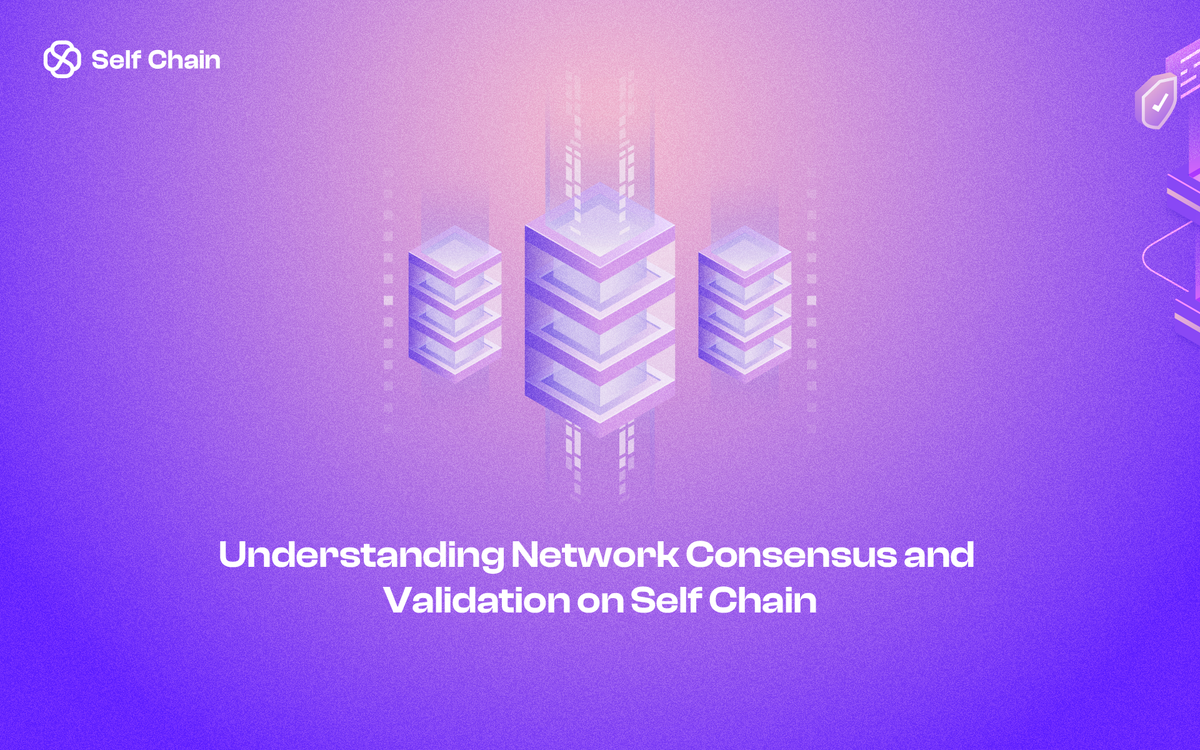Understanding Network Consensus and Validation on Self Chain
Self Chain operates as a delegated proof-of-stake (DPoS) blockchain, utilizing Tendermint consensus—a highly secure and scalable mechanism.

Self Chain operates as a delegated proof-of-stake (DPoS) blockchain, utilizing Tendermint consensus—a highly secure and scalable mechanism. At the core of this system are validators, who are responsible for adding new blocks to the chain and ensuring the security and integrity of the network.
In this article, we’ll explore how Self Chain’s consensus mechanism works, the role of validators, and the key processes like staking, rewards, and slashing.
How Does Tendermint Consensus Work?
Tendermint is the consensus algorithm powering Self Chain. This algorithm ensures that all validators agree on the state of the blockchain by following a series of steps:
- Block Proposer Selection: A validator is chosen to submit a new block of transactions. This process is called “proposing.”
- Voting Process: Other validators vote on whether to accept or reject the proposed block. If the block is rejected, a new proposer is selected, and the process starts again.
- Block Finalization: If the block is accepted, it is signed and added to the blockchain.
- Rewards: The validators and delegators receive rewards for their participation in securing the network. The proposer receives additional rewards for their role.
This cycle ensures that multiple validators check and verify each block, safeguarding the network from malicious or incorrect transactions.
The Role of Validators
Validators are key players in the Self Chain ecosystem. They are responsible for validating new transactions and proposing new blocks. Validators run full nodes, which maintain a copy of the blockchain and compare new transactions with the existing chain to ensure accuracy.
Validator Selection: In Self Chain, the top 100 validators participate in consensus. Validators are ranked by the total amount of $SLF staked to them, either through self-bonding or delegators.
Earning Rewards: Validators earn staking rewards from transaction fees and inflation rewards for proposing and validating blocks.
Staking for Security: Validators secure the network by staking $SLF, and they are incentivized to act honestly. If they misbehave or fail to perform their duties, they risk losing their staked tokens through a process known as slashing.
Staking and Delegators
Self Chain’s staking mechanism allows users to secure the network and earn rewards by staking their $SLF tokens. Users can either become validators themselves or delegate their tokens to existing validators. In return, they earn a portion of the rewards.
- Bonding: When users stake their $SLF tokens to a validator, those tokens are "bonded" to the validator and used to participate in consensus.
- Unbonding: Users can unstake their tokens through the unbonding process, which takes 21 days to complete.
- Redelegation: Users can move their staked tokens from one validator to another without going through the unbonding period, providing flexibility in how they participate in staking.
Rewards and Incentives
Self Chain incentivizes both validators and delegators through rewards distributed from two sources:
- Gas Fees: Validators and delegators receive a portion of the transaction fees as staking rewards. This discourages spam transactions and ensures that validators are compensated for their services.
- Inflation Rewards: New $SLF tokens are minted with each block and distributed to validators and delegators. This inflation is set at a fixed rate of 5% per year.
Slashing: Ensuring Validator Accountability
Running a validator is a significant responsibility. Validators who act dishonestly or fail to meet the network’s requirements face penalties in the form of slashing. When slashed, a validator loses part of their staked tokens, along with a portion of their delegators’ stakes.
Slashing occurs under three main conditions:
- Double signing: If a validator signs two different blocks at the same height, their stake is slashed.
- Downtime: If a validator is unresponsive or unreachable for an extended period, they are slashed for failing to participate in consensus.
- Missed votes: Validators must vote in consensus rounds, and failure to vote results in slashing.
These penalties encourage validators to maintain high standards of reliability and security.
Conclusion
Self Chain’s consensus and validation processes are designed to ensure the security and scalability of the network while rewarding active participation. With its delegated proof-of-stake mechanism and Tendermint consensus, Self Chain offers a robust and efficient blockchain system that encourages user engagement through staking and rewards, while also maintaining validator accountability through slashing.
By staking $SLF, users help secure the network and can participate in its growth, receiving rewards for their contribution. Validators and delegators alike play a crucial role in maintaining the integrity of the Self Chain ecosystem, making it a community-driven, decentralized blockchain.
About Self Chain
Self Chain is the first Modular Intent-Centric Access Layer1 blockchain and keyless wallet infrastructure service using MPC-TSS/AA for multi-chain Web3 access. The innovative system simplifies the user experience with its intent-focused approach, using LLM to interpret user intent and discover the most efficient paths.
Self Chain ensures that onboarding and recovery are effortless with keyless wallets that grant users complete self-custody over their assets. In addition, it provides automated rewards to dApps when they efficiently resolve user intent, further enhancing the user experience. Moreover, Self Chain incorporates Account Abstraction with MPC-TSS to provide secure signing and reduce transaction fees. It's a platform that redefines blockchain interaction, making it more secure and user-friendly for everyone.
In a world where blockchain technology is becoming increasingly essential, the user experience remains a critical factor in its adoption. Intents and Keyless Wallets are set to transform the landscape, making blockchain interactions more accessible, efficient, and secure. As we move forward, the blockchain industry has the opportunity to provide users with a seamless and enjoyable experience, unlocking the full potential of this groundbreaking technology.
